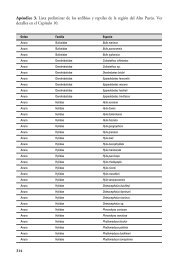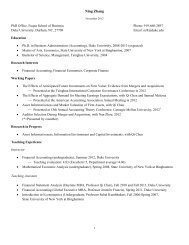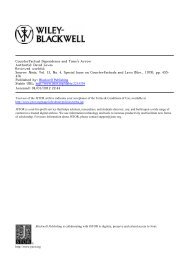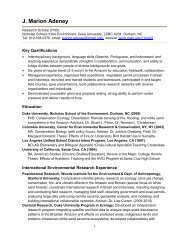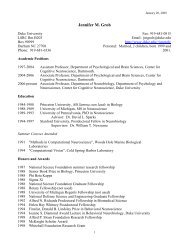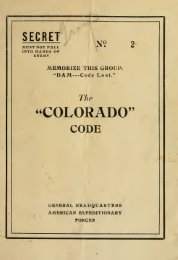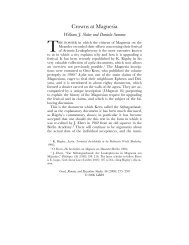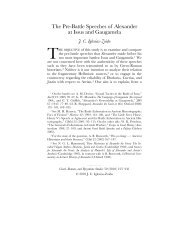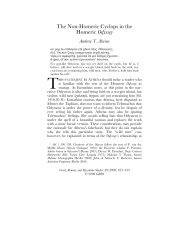Johann Wolfgang von Goethe (1749-1832) - Duke University
Johann Wolfgang von Goethe (1749-1832) - Duke University
Johann Wolfgang von Goethe (1749-1832) - Duke University
You also want an ePaper? Increase the reach of your titles
YUMPU automatically turns print PDFs into web optimized ePapers that Google loves.
J. W. v. <strong>Goethe</strong> Page 6 4/4/2008<br />
which he had begun shortly before leaving<br />
Frankfurt; on successive versions, mainly in prose,<br />
of Iphigenie auf Tauris: Ein Schauspiel, published in<br />
its final blank verse version in 1787 (translated as<br />
Iphigenia: A Tragedy, 1793); and on Torquato Tasso:<br />
Ein Schauspiel (1790; translated, 1861). He also wrote<br />
Wilhelm Meisters theatralische Sendung (Wilhelm<br />
Meister's Theatrical Mission, 1911), a lively<br />
fragment about the state of the German theater.<br />
The pressure of all these competing interests finally<br />
became too great, and <strong>Goethe</strong> fled to Italy, leaving<br />
Carlsbad in secret early in the morning of 3<br />
September 1786. He recorded his impressions at the<br />
time in a diary for Frau <strong>von</strong> Stein; later he drew<br />
heavily on this diary for his Aus meinem Leben,<br />
zweyter Abtheilung erster Theil, zweyter Theil:<br />
Italienische Reise (1817; translated as Travels in Italy,<br />
1846). In his reflections on Italy and his experiences<br />
there the interests and developments of the<br />
previous twelve years coalesce and become clearly<br />
articulated. <strong>Goethe</strong> had always expected to<br />
complete his education with a journey to Italy, as<br />
his father had, and twice before he had almost set<br />
out on that journey. The trip came to signify for him<br />
a rebirth, not only into a new life but into what he<br />
was always going to become: at several levels it was<br />
a journey of self-recovery. But it was in no sense a<br />
journey into himself, for his main concern was to<br />
look at objects as much as possible for themselves-at<br />
the rocks and the plants; the customs, theatricals,<br />
and festivals of the people (but never their feelings<br />
or political concerns); architecture, sculpture, and,<br />
to a lesser extent, painting. His Italy was the Italy of<br />
the high Renaissance, which included and<br />
subsumed ancient Roman Italy. Apart from brief<br />
stays in Venice and Naples and a tour of Sicily,<br />
<strong>Goethe</strong> spent all of his time in Rome, visiting<br />
galleries and monuments to study painting and<br />
sculpture. For most of his stay he socialized only<br />
with the German art colony, especially with<br />
Wilhelm Tischbein and Angelika Kauffmann. He<br />
revised and completed Egmont: Ein Trauerspiel in<br />
fünf Aufzügen , Iphigenie auf Tauris: Ein Schauspiel,<br />
and part of Torquato Tasso: Ein Schauspiel for the<br />
edition of his works that was under way (1787-<br />
1790); he also added two scenes to the version of<br />
Faust that he had composed before he left<br />
Frankfurt for Weimar, and selected from his<br />
Faust materials scenes that he published in<br />
preliminary form as Faust: Ein Fragment (1790).<br />
The three plays <strong>Goethe</strong> revised are usually<br />
considered the core of his "classical" works, the<br />
first efflorescence of the objective style he<br />
developed in Italy. Egmont: Ein Trauerspiel in fünf<br />
Aufzügen is still concerned with the tragedy of<br />
the genius too great for the world around him<br />
and with the problem of his consciousness, but<br />
from the opposite point of view from that of Die<br />
Leiden des jungen Werthers. If the latter portrays<br />
tragic preoccupation with the self, Egmont: Ein<br />
Trauerspiel in fünf Aufzügen articulates the<br />
tragedy of what <strong>Goethe</strong> called "das<br />
Dämonische" (the demonic), that pure<br />
unconsciousness that is in direct contact with<br />
the wellsprings of being. Comparing himself to<br />
a sleepwalker, Egmont, prince of Garve, refuses<br />
to be self-conscious, refuses to be interpretable,<br />
or to interpret the behavior of others. Immensely<br />
popular with the people of the Netherlands,<br />
who are suffering under the rule of Philip II of<br />
Spain, Egmont ignores warnings that neither his<br />
rank, his record of service, nor his standing with<br />
the people can save him when the regime<br />
decides he is too dangerous. Rejecting all<br />
intrigue, he walks blindly into a trap set by the<br />
wily <strong>Duke</strong> of Alba; but, like Götz <strong>von</strong><br />
Berlichingen, he finds freedom just before his<br />
death in a vision of his mistress, Klärchen, as<br />
Freedom personified. The classicism of this play<br />
may best be identified in its symbolic, operatic,<br />
yet still intensely psychological language and<br />
themes. The play, which is in rhythmic prose,<br />
ranges in tone from Shakespearean mob scenes<br />
to what Friedrich Schiller called a "salto mortale<br />
in eine Opernwelt" (somersault into opera) at<br />
the end; actually, in their choral effects and the<br />
way that they symbolize the situation of the<br />
hero, the mob scenes are already operatic.<br />
<strong>Goethe</strong> was no longer imitating Shakespeare but<br />
had absorbed him into a new dramatic form of<br />
his own making.



